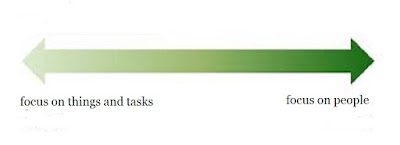“They talk about high functioning autism as being a ‘disorder’, which I don’t like that term. In any event, what is the difference between a ‘disorder’ and the normal range of abilities and personality?”
All behaviors fall along a continuum or spectrum. At one end of the spectrum is “normal” behavior, abilities, individual characteristics that are considered appropriate (or typical) on the basis of an individual’s culture, age, gender, etc.
At the other end of the spectrum are groups of behaviors that, when exhibited regularly by an individual, create problems for that person in terms of his or her functioning socially, emotionally, or occupationally.
Most people have certain idiosyncrasies (e.g., unusual hobbies, anxiety, awkwardness in social situations, clumsiness, obsessions, etc.). This is considered well within the range of normal behavior.
However, when these behaviors overlap, form a pattern across time, and negatively impact a person’s ability to function, then they are viewed as “clinically significant,” and as requiring diagnosis and treatment.
There is a lot of controversy about the diagnosis of High-Functioning Autism (HFA) and Asperger’s. Some people view this as simply a different way of thinking and viewing the world.
Added to the mix is concern that people with poor social skills are being “pathologized.” In other words, the “loners” are now qualifying for a diagnosis.
Our society expects people to be social. When they are not, should we view them as sociopathic or disabled? Simon Baron-Cohen explored this argument and looked at both sides. He suggested that many of the behaviors associated with the “disorder” represent a focus on things rather than on people. They spend most of their time completing tasks rather than socializing.
If placed in a different environment, Baron-Cohen believed that Asperger’s would not be seen as a “disorder.” He also pointed out that kids on the high functioning end of the autism spectrum tend to meet the majority of developmental milestones on time – and emphasized the typical or “normal” aspect of their development.
In contrast, he also discussed two reasons for continuing to consider Asperger’s a “disability”:
All behaviors fall along a continuum or spectrum. At one end of the spectrum is “normal” behavior, abilities, individual characteristics that are considered appropriate (or typical) on the basis of an individual’s culture, age, gender, etc.
At the other end of the spectrum are groups of behaviors that, when exhibited regularly by an individual, create problems for that person in terms of his or her functioning socially, emotionally, or occupationally.
Most people have certain idiosyncrasies (e.g., unusual hobbies, anxiety, awkwardness in social situations, clumsiness, obsessions, etc.). This is considered well within the range of normal behavior.
However, when these behaviors overlap, form a pattern across time, and negatively impact a person’s ability to function, then they are viewed as “clinically significant,” and as requiring diagnosis and treatment.
There is a lot of controversy about the diagnosis of High-Functioning Autism (HFA) and Asperger’s. Some people view this as simply a different way of thinking and viewing the world.
Added to the mix is concern that people with poor social skills are being “pathologized.” In other words, the “loners” are now qualifying for a diagnosis.
Our society expects people to be social. When they are not, should we view them as sociopathic or disabled? Simon Baron-Cohen explored this argument and looked at both sides. He suggested that many of the behaviors associated with the “disorder” represent a focus on things rather than on people. They spend most of their time completing tasks rather than socializing.
If placed in a different environment, Baron-Cohen believed that Asperger’s would not be seen as a “disorder.” He also pointed out that kids on the high functioning end of the autism spectrum tend to meet the majority of developmental milestones on time – and emphasized the typical or “normal” aspect of their development.
In contrast, he also discussed two reasons for continuing to consider Asperger’s a “disability”:
- so that individuals with this diagnosis could have access to support at school (e.g., through special education services) and within the community (e.g., some insurance companies will pay for the affected individual to get treatment in outpatient therapy)
- because lack of empathy (i.e., theory of mind) can create significant problems emotionally for people with Asperger’s and HFA
In summary, a “disorder” is a behavioral or mental pattern that causes significant distress or impairment in a person’s ability to function effectively and consistently in day-to-day living (e.g., physically, mentally, emotionally, socially, financially, vocationally - and even spiritually).
This is where some controversy enters the picture, because many (if not most) people on the higher end of the autism spectrum would say they "function" just fine in most areas of life (although most would admit to certain areas of struggle as well).
Resources for parents of children and teens on the autism spectrum:
==> How to Prevent Meltdowns and Tantrums in Children with Autism Spectrum Disorder
==> Parenting System that Reduces Defiant Behavior in Teens with Autism Spectrum Disorder
==> Launching Adult Children with Autism Spectrum Disorder: Guide for Parents Who Want to Promote Self-Reliance
==> Teaching Social-Skills and Emotion-Management to Children with Autism Spectrum Disorder
==> Parenting Children and Teens with High-Functioning Autism: Parents' Comprehensive Handbook
==> Unraveling the Mystery Behind High-Functioning Autism: Audio Book
==> Crucial Research-Based Parenting Strategies for Children and Teens with High-Functioning Autism
==> Parenting System that Reduces Defiant Behavior in Teens with Autism Spectrum Disorder
==> Launching Adult Children with Autism Spectrum Disorder: Guide for Parents Who Want to Promote Self-Reliance
==> Teaching Social-Skills and Emotion-Management to Children with Autism Spectrum Disorder
==> Parenting Children and Teens with High-Functioning Autism: Parents' Comprehensive Handbook
==> Unraveling the Mystery Behind High-Functioning Autism: Audio Book
==> Crucial Research-Based Parenting Strategies for Children and Teens with High-Functioning Autism













.jpg)


